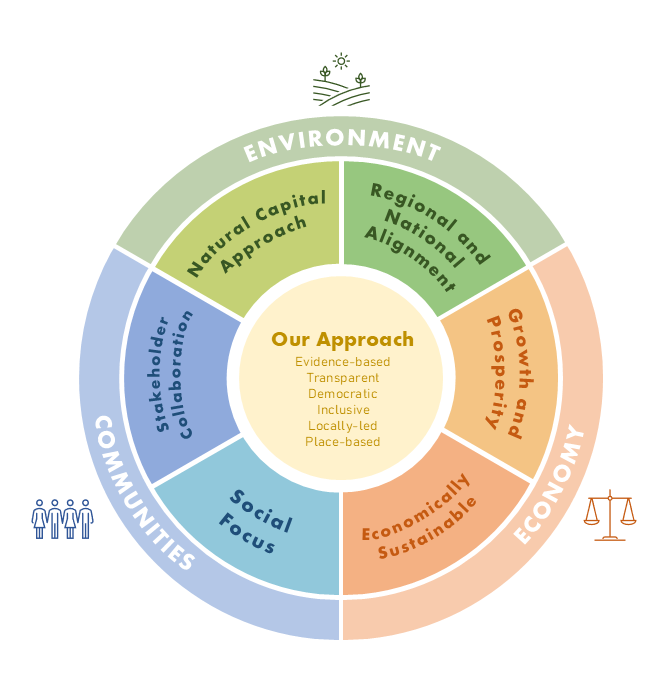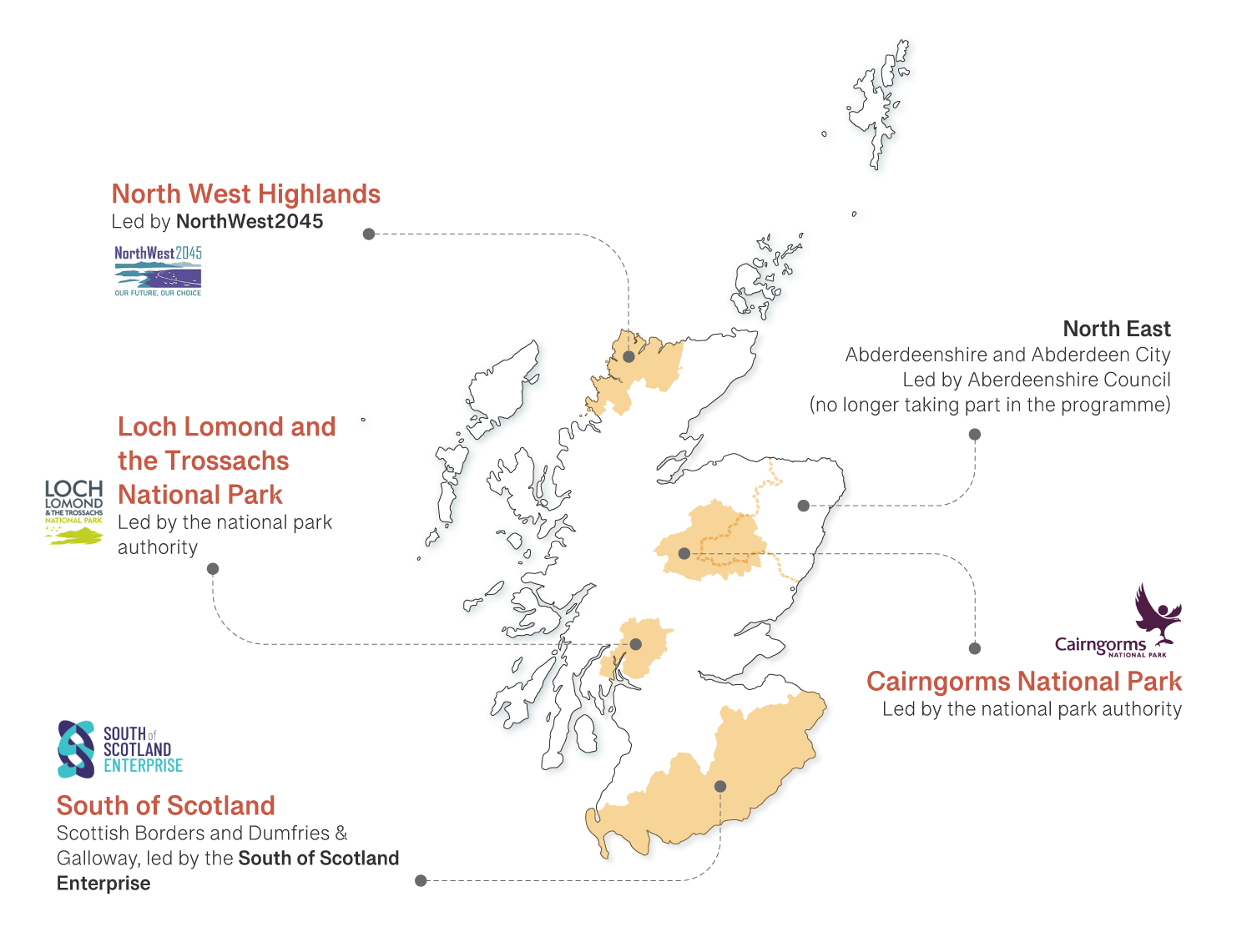Regional Land Use Partnerships
About
Regional Land Use Partnerships (RLUPs) aim to facilitate inclusive and democratic partnership working between all land users, including local and national government, communities, landowners, land managers and wider stakeholders.
They adopt a natural capital approach to understanding their regional landscapes, which helps recognise the financial value that natural ecosystems contribute to key aspects of human life. For example, restoring woodlands allows more carbon to be captured and increases the quality of the air we breathe, whereas peatland restoration can improve the quality of drinking water for those in the surrounding area.
Background
The concept of land use partnerships was first piloted in Scotland in 2015 in the South of Scotland (Scottish Borders and Dumfries and Galloway) and Aberdeenshire regions.
Building on this work, and in response to the recommendations of Scottish Land Commission’s report into RLUPs in 2021, five regions embarked on a larger pilot, with the aim of determining what land use partnerships could look like in different areas of the country.
The five regions consisted of:
- South of Scotland – Scottish Borders and Dumfries and Galloway, led by the South
of Scotland Enterprise - North West Highlands – specifically the NorthWest2045 area of operation, with an additional focus on Kinlochbervie
- Cairngorms National Park – led by the national park authority
- Loch Lomond and the Trossachs National Park – led by the national park authority
- North East – Aberdeenshire and Aberdeen City, led by the respective Local
Authorities (this region is no longer taking part in the programme)
"The RLUP pilot has empowered our communities, business and enivronmental interests in a way that has not been possible to date."
Progress
In March 2024 the pilot programme was concluded and an internal evaluation of progress against its founding objectives was taken forward. Those objectives were to:
- Test approaches to partnership governance that best suit the local situation and priorities
- Provide a platform for communities, land owners, land managers and farmers
across the region to share their views on what land use means to them - Employ a natural capital approach to regional land use
- Develop a framework that sets out the opportunities and priorities that each
region considers for land use
The evaluation provided evidence that the majority of the pilots were successful in meeting these objectives, as well as highlighting the potential for RLUPs to support a number of the Scottish Government’s ambitions.
Based on this evaluation and the work of the regions the Cabinet Secretary for Rural Affairs, Land Reform and Islands, Mairi Gougeon, decided to transition the RLUPs from pilot programme to a formal initiative, supporting those regions which wish to do so, to further develop the approach.

Examples of spatial mapping deployed by the RLUPs, identifying ecosystems at the regional scale.
“I am delighted to continue to support Regional Land Use Partnerships. As the report illustrates, this initiative has great potential to bring local and national interests closer together, empowering people to consider how land is used in their locality and how it could contribute to our wider national ambitions around climate change, biodiversity loss and sustainable rural communities.”
Evaluation
The evaluation identified the following headline findings:
- Four of the five pilot regions have successfully met the outcomes set for this phase.
- The level of engagement and interest from participants has demonstrated the importance of land to rural Scotland and the appetite for a forum like RLUPs.
- Providing stakeholders, landowners, and communities with the mechanism to collaborate has allowed them to identify successes, challenges, and opportunities regarding land use, and make connections that did not exist before the pilot.
- RLUPs have provided a great opportunity to begin to demystify the concept of natural capital whilst emphasising the multiple benefits its enhancement can bring.
- RLUPs can provide a platform to assist in the delivery of multiple national ambitions, e.g. private investment in natural capital, peatland restoration, woodland protection/creation, nature networks, community wealth building and local place planning.
- There is no equivalent platform currently known in Scotland to bring such as wide range of interests together to discuss land use and land use change.
- There is no one size fits all approach to success, the flexibility to tailor the approach throughout the regions has been a key strength of the RLUPs process.
For more information on the findings of the evaluation, please view the summary report below:

"The involvement of young local people with an enduring connection to the land and culture is refreshing and a hugely hopeful sign."
Regional Land Use Framework
Regional Land Use Frameworks (RLUF) are aimed at setting out the opportunities and priorities that each region considers for land use.
In keeping with the RLUP principles, there is no one size fits all approach for developing an RLUF. Instead, they should be structured in a way that is most appropriate for each region, co-developed with regional stakeholders, and be guided by the feedback gathered throughout extensive consultation and engagement.
During the pilot, the Scottish Government worked with the RLUP regional leads to develop a set of guiding principles to support an overarching consistency across RLUF development.
The RLUF guiding principles have been developed using key national and international land use strategies and are framed within the relevant National Performance Framework outcomes.

Environment
Natural Capital Approach
- Approach our land as an asset that we need to protect and enhance so that it can continue to deliver ecosystem benefits
- Using appropriate data to identify regional natural capital assets to address climate change and biodiversity loss
- Mitigate against a changing climate through nature-based solutions
Regional and National Alignment
- Ensure that local knowledge and experience influences national policy, helping to navigate complex ecologies and improve resilience
- Regional land use plays an active role in supporting Scotland to deliver a wellbeing economy and just transition to Net Zero
- Consider the optimal use for land, taking into account the ecological and social context
Communities
Stakeholder Collaboration
- Collaborate with a range of stakeholders and strive to seek alignment where competing interests are at play
- Maintain a democratic and inclusive approach to decision-making with clear routes for resolving conflict
Social Focus
- Channel place-based principles that support communities to stay connected to the land and each other
- Seek opportunities for communities to develop understanding and take active ownership of land use issues
Economy
Growth and Prosperity
- Ensuring that Scotland’s people can live and work sustainably on our land
- Strengthen our rural and island communities and businesses by supporting and empowering them to become sustainable and vibrant places to live, work and study
Economic Sustainability
- Identify opportunities for high integrity green investment that delivers mutual benefits for communities and investors
- Understanding the economic behaviours and incentives underpinning regional land use to better encourage mutual prosperity for all
The next chapter
The Scottish Government is continuing to work with the 4 RLUPs, seeking to further develop and expand the partnerships’ position as a platform to support collaborative, inclusive and innovative approaches to land use and land use change discussions, decision making and delivery. Each RLUP will be supported in their locally appropriate approach as they look to stimulate, support and deliver actions aimed at supporting both natural capital improvements and community benefits, as well as helping to continue building an evidence base to inform future thinking on regional and sub-regional collaboration.
An ongoing element of this is to work with the RLUPs to consider a number of different land-based national ambitions including, but not limited to:
- Private investment in natural capital
- Agricultural reform
- Forestry
- Peatland
- Biodiversity
- Planning
- Renewable Energy
- Wider regional partnerships (such as Regional Economic Partnerships and Climate Action Hubs)








